Five Years of Spatially Resolved Ground-Based MAX-DOAS Measurements of Nitrogen Dioxide in the Urban Area of Athens: Synergies with In Situ Measurements and Model Simulations
Abstract
:1. Introduction
2. Methodology
2.1. The MAX-DOAS System
2.2. Model Simulations
2.3. In Situ NO2 Monitors
3. Results and Discussion
3.1. Comparisons with In Situ Observations
3.2. Annual Cycles and Spatial Variability
3.3. Vertical Changes in Diurnal Variation
3.4. Contribution of Urban Sources
4. Summary and Conclusions
Author Contributions
Funding
Data Availability Statement
Acknowledgments
Conflicts of Interest
References
- Seinfeld, J.H.; Pandis, S.N. Atmospheric Chemistry and Physics: From Air Pollution to Climate Change. Environ. Sci. Policy Sustain. Dev. 1998, 40, 26. [Google Scholar] [CrossRef]
- Solomon, S.; Portmann, R.W.; Sanders, R.W.; Daniel, J.S.; Madsen, W.; Bartram, B.; Dutton, E.G. On the role of nitrogen dioxide in the absorption of solar radiation. J. Geophys. Res. 1999, 104, 12047–12058. [Google Scholar] [CrossRef]
- Hewitt, C.N.; Jackson, A.V. Atmospheric Science for Environmental Scientists; Wiley-Blackwell: Chichester, UK, 2009. [Google Scholar]
- Pascal, M.; Corso, M.; Chanel, O.; Declerq, C.; Bandaloni, C.; Cesaroni, G.; Henschel, S.; Meister, K.; Haluza, D.; Martin-Olmedo, P.; et al. Assessing the public health impacts of urban air pollution in 25 European cities: Results of the Aphekom project. Sci. Total Environ. 2013, 449, 390–400. [Google Scholar] [CrossRef] [PubMed]
- Mavroidis, I.; Ilia, M. Trends of NOX, NO2 and O3 concentrations at three different types of air quality monitoring stations in Athens, Greece. Atmos. Chem. Phys. 2012, 63, 135–147. [Google Scholar] [CrossRef]
- Khomenko, S.; Cirach, M.; Pereira-Barboza, E.; Mueller, N.; Barrera-Gómez, J.; Rojas-Rueda, D.; de Hoogh, K.; Hoek, G.; Nieuwenhuijsen, M. Premature mortality due to air pollution in European cities; an Urban Burden of Disease Assessment. Lancet Planet. Health 2021, 5, e121–e134. [Google Scholar] [CrossRef]
- Lalas, D.P.; Veirs, V.R.; Karras, G.; Kallos, G. An analysis of the SO2 concentration levels in Athens, Greece. Atmos. Environ. 1982, 16, 531–544. [Google Scholar] [CrossRef]
- Kassomenos, P.; Kotroni, V.; Kallos, G. Analysis of climatological and air quality observations from greater Athens area. Atmos. Environ. 1995, 29, 3671–3688. [Google Scholar] [CrossRef]
- Markakis, K.; Poupkou, A.; Melas, D.; Tzoumaka, P.; Petrakakis, M. A computational approach based on GIS technology for the development of an anthropogenic emission inventory for air quality applications in Greece. Water Air Soil Pollut. 2010, 207, 157–180. [Google Scholar] [CrossRef]
- Lalas, D.; Assimakopoulos, D.; Deligiorgi, D.; Helmis, C. Sea breeze circulation and photochemical pollution in Athens, Greece. Atmos. Environ. 1983, 17, 1621–1632. [Google Scholar] [CrossRef]
- Viras, L.; Siskos, P. Air pollution by gaseous pollutants in Athens, Greece. In Gaseous Pollutants: Characterization and Cycling; Nriagu, J.O., Ed.; Wiley-Interscience: Hoboken, NJ, USA, 1992; pp. 271–305. [Google Scholar]
- Kalabokas, P.; Viras, L.; Repapis, C. Analysis of the 11-year record (1987–1997) of air pollution measurements in Athens, Greece. Part I: Primary air pollutants. Glob. Nest Int. J. 1999, 1, 157–167. [Google Scholar]
- Kalabokas, P.D.; Papayannis, A.D.; Tsaknakis, G.; Ziomas, I. Study on the atmospheric concentrations of primary and secondary air pollutants in the Athens basin performed by DOAS and DIAL measuring techniques. Sci. Total Environ. 2012, 414, 556–563. [Google Scholar] [CrossRef] [PubMed]
- Psiloglou, B.; Larissi, I.; Petrakis, M.; Paliatsos, A.; Antoniou, A.; Viras, L. Case studies on summertime measurements of O3, NO2 and SO2 with a DOAS system in an urban semi-industrial region in Athens, Greece. Environ. Monit. Assess. 2013, 185, 7763–7774. [Google Scholar] [CrossRef] [PubMed]
- Wittrock, F.; Oetjen, H.; Richter, A.; Fietkau, S.; Medeke, T.; Rozanov, A.; Burrows, J.P. MAX-DOAS measurements of atmospheric trace gases in Ny-Alesund. Atmos. Chem. Phys. 2004, 4, 955–966. [Google Scholar] [CrossRef] [Green Version]
- Ma, J.Z.; Beirle, S.; Jin, J.L.; Shaiganfar, R.; Yan, P.; Wagner, T. Tropospheric NO2 vertical column densities over Beijing: Results of the first three years of ground-based MAX-DOAS measurements (2008–2011) and satellite validation. Atmos. Chem. Phys. 2013, 13, 1547–1567. [Google Scholar] [CrossRef] [Green Version]
- Schreier, S.F.; Richter, A.; Peters, E.; Ostendorf, M.; Schmalwieser, A.W.; Weihs, P.; Burrows, J.P. Dual ground-based MAX-DOAS observations in Vienna, Austria: Evaluation of horizontal and temporal NO2, HCHO and CHOCHO distributions and comparison with independent data sets. Atmos. Environ. X 2020, 5, 100059. [Google Scholar] [CrossRef]
- Kramer, L.; Leigh, R.; Remedios, J.; Monks, P. Comparison of OMI and ground-based in situ and MAX-DOAS measurements of tropospheric nitrogen dioxide in an urban area. J. Geophys. Res. Atmos. 2008, 113, D16. [Google Scholar] [CrossRef]
- Hendrick, F.; Müller, J.F.; Clémer, K.; Wang, P.; De Mazière, M.; Fayt, C.; Gielen, C.; Hermans, C.; Ma, J.Z.; Pinardi, G.; et al. Four years of ground-based MAX-DOAS observations of HONO and NO2 in the Beijing area. Atmos. Chem. Phys. 2014, 14, 765–781. [Google Scholar] [CrossRef] [Green Version]
- Arellano, J.; Kruger, A.; Rivera, C.; Stremme, W.; Friedrich, M.; Bezanilla, A.; Grutter, M. The MAX-DOAS Network in Mexico City to Measure Atmospheric Pollutants; Centro de Ciencias de la Atmosfera, Universidad Nacional Autonoma de Mexico, Circuito Exterior, Ciudad Universitaria: Ciudad de Mexico, Mexico, 2016; ISSN 0187-6236. [Google Scholar]
- Drosoglou, T.; Bais, A.F.; Zyrichidou, I.; Kouremeti, N.; Poupkou, A.; Liora, N.; Giannaros, C.; Koukouli, M.E.; Balis, D.; Melas, D. Comparisons of ground-based tropospheric NO2 MAX-DOAS measurements to satellite observations with the aid of an air quality model over the Thessaloniki area, Greece. Atmos. Chem. Phys. 2017, 17, 5829–5849. [Google Scholar] [CrossRef] [Green Version]
- Karagkiozidis, D.; Friedrich, M.M.; Beirle, S.; Bais, A.; Hendrick, F.; Voudouri, K.A.; Fountoulakis, I.; Karanikolas, A.; Tzoumaka, P.; Van Roozendael, M.; et al. Retrieval of tropospheric aerosol, NO2 and HCHO vertical profiles from MAX-DOAS observations over Thessaloniki, Greece. Atmos. Meas. Tech. Discuss. 2021. [Google Scholar] [CrossRef]
- Gratsea, M.; Vrekoussis, M.; Richter, A.; Wittrock, F.; Schonhardt, A.; Burrows, J.; Kazadzis, S.; Mihalopoulos, N.; Gerasopoulos, E. Slant column MAX-DOAS measurements of nitrogen dioxide, formaldehyde, glyoxal and oxygen dimer in the urban environment of Athens. Atmos. Environ. 2016, 135, 118–131. [Google Scholar] [CrossRef]
- Skoulidou, I.; Koukouli, M.E.; Manders, A.; Segers, A.; Karagkiozidis, D.; Gratsea, M.; Balis, D.; Bais, A.; Gerasopoulos, E.; Stavrakou, T.; et al. Evaluation of the LOTOS-EUROS NO2 simulations using ground-based measurements and S5P/TROPOMI observations over Greece. Atmos. Chem. Phys. 2021, 21, 5269–5288. [Google Scholar] [CrossRef]
- Leigh, R.J.; Corlett, G.K.; Frieb, U.; Monks, P.S. Spatially resolved measurements of nitrogen dioxide in an urban environment using concurrent multi-axis differential optical absorption spectroscopy. Atmos. Chem. Phys. 2007, 7, 4751–4762. [Google Scholar] [CrossRef] [Green Version]
- Brinksma, E.J.; Pinardi, G.; Volten, H.; Braak, R.; Richter, A.; Schonhardt, A.; van Roozendael, M.; Fayt, C.; Hermans, C.; Dirksen, R.J.; et al. The 2005 and 2006 DANDELIONS NO2 and aerosol intercomparison campaigns. J. Geophys. Res. 2008, 113, D16S46. [Google Scholar] [CrossRef] [Green Version]
- Gratsea, M.; Bosch, T.; Kokkalis, P.; Richter, A.; Vrekoussis, M.; Kazadzis, S.; Tsekeri, A.; Papayannis, A.; Mylonaki, M.; Amiridis, V.; et al. Retrieval and evaluation of tropospheric aerosol extinction profiles using multi-axis differential absorption spectroscopy (MAX-DOAS) measurements over Athens, Greece. Atmos. Meas. Tech. 2021, 14, 749–767. [Google Scholar] [CrossRef]
- Richter, A. Absorptionsspektroskopische Messungen Stratosphaerischer Spurengase Ueber Bremen 53 N. Ph.D. Thesis, University of Bremen, Bremen, Germany, 1997. [Google Scholar]
- Peters, E.; Pinardi, G.; Seyler, A.; Richter, A.; Wittrock, F.; Bosch, T.; Van Roozendael, M.; Hendrick, F.; Drosoglou, T.; Bais, A.F.; et al. Investigating differences in DOAS retrieval codes using MAD-CAT campaign data. Atmos. Meas. Tech. 2017, 10, 955–978. [Google Scholar] [CrossRef] [Green Version]
- Vandaele, A.C.; Hermans, C.; Simon, P.C.; Carleer, M.; Colin, R.; Fally, S.; Merienne, M.F.; Jenouvrier, A.; Coquart, B. Measurements of the NO2 absorption cross section from 42,000 cm−1 to 10,000 cm−1 (238–1000 nm) at 220 K and 294 K. J. Quant. Spectrosc. Radiat. Transf. 1998, 52, 171–184. [Google Scholar] [CrossRef] [Green Version]
- Honninger, G.; von Friedeburg, C.; Platt, U. Multi axis differential optical absorption spectroscopy (MAX-DOAS). Atmos. Chem. Phys. 2004, 4, 231–254. [Google Scholar] [CrossRef] [Green Version]
- Leser, H.; Honninger, G.; Platt, U. MAX-DOAS measurements of BrO and NO2 in the marine boundary layer. Geophys. Res. Lett. 2003, 30, 1537. [Google Scholar] [CrossRef]
- Halla, J.D.; Wagner, T.; Beirle, S.; Brook, J.R.; Hayden, K.L.; O’Brien, J.M.; Ng, A.; Majonis, D.; Wenig, M.O.; McLaren, R. Determination of tropospheric vertical columns of NO2 and aerosol optical properties in a rural setting using MAX-DOAS. Atmos. Chem. Phys. 2011, 11, 12475–12498. [Google Scholar] [CrossRef] [Green Version]
- Schreier, S.F.; Peters, E.; Richter, A.; Lampel, J.; Wittrock, F.; Burrows, J.P. Ship-based MAX-DOAS measurements of tropospheric NO2 and SO2 in the South China and Sulu Sea. Atmos. Environ. 2015, 102, 331–343. [Google Scholar] [CrossRef]
- Hurley, P.; Physick, W.; Luhar, A. TAPM—A practical approach to prognostic meteorological and air pollution modelling. Environ. Modell. Softw. 2005, 20, 737–752. [Google Scholar] [CrossRef]
- Ramacher, M.O.P.; Kakouri, A.; Speyer, O.; Feldner, J.; Karl, M.; Timmermans, R.; Denier van der Gon, H.; Kuenen, J.; Gerasopoulos, E.; Athanasopoulou, E. The UrbEm Hybrid Method to Derive High-Resolution Emissions for City-Scale Air Quality Modeling. Atmosphere 2021, 12, 1404. [Google Scholar] [CrossRef]
- Hurley, P.; Manins, P.; Lee, S.; Boyle, R.; Ng, Y.L.; Dewundege, P. Year-long, high-resolution, urban airshed modelling: Verification of TAPM predictions of smog and particles in Melbourne, Australia. Atmos. Environ. 2003, 37, 1899–1910. [Google Scholar] [CrossRef]
- Luhar, A.K.; Hurley, P.J. Evaluation of TAPM, a prognostic meteorological and air pollution model, using urban and rural point-source data. Atmos. Environ. 2003, 37, 2795–2810. [Google Scholar] [CrossRef]
- Karl, M.; Walker, S.-E.; Solberg, S.; Ramacher, M.O.P. The Eulerian urban dispersion model EPISODE—Part 2: Extensions to the source dispersion and photochemistry for EPISODE—CityChem v1.2 and its application to the city of Hamburg. Geosci. Model Dev. 2020, 12, 3357–3399. [Google Scholar] [CrossRef] [Green Version]
- Grivas, G.; Athanasopoulou, E.; Kakouri, A.; Bailey, J.; Liakakou, E.; Stavroulas, I.; Kalkavouras, P.; Bougiatioti, A.; Kaskaoutis, D.G.; Ramonet, M.; et al. Integrating in situ Measurements and City Scale Modelling to Assess the COVID–19 Lockdown Effects on Emissions and Air Quality in Athens, Greece. Atmosphere 2020, 11, 1174. [Google Scholar] [CrossRef]
- Roorda-Knape, M.C.; Janssen, N.A.; Hartog, J.; Van Vliet, P.H.; Harssema, H.; Brunekreef, B. Air pollution from traffic in city districts near major motorways. Atmos. Environ. 1998, 32, 1921–1930. [Google Scholar] [CrossRef]
- Petritoli, A.; Bonasoni, P.; Giovanelli, G.; Ravegnani, F.; Kostadinov, I.; Bortoli, D.; Weiss, A.; Schaub, D.; Richter, A.; Fortezza, F. First comparison between ground-based and satellite-borne measurements of tropospheric nitrogen dioxide in the Po basin. J. Geophys. Res. 2004, 109, D15307. [Google Scholar] [CrossRef] [Green Version]
- Kumar, V.; Remmers, J.; Beirle, S.; Fallmann, J.; Kerkweg, A.; Lelieveld, J.; Mertens, M.; Pozzer, A.; Steil, B.; Barra, M.; et al. Evaluation of the coupled high-resolution atmospheric chemistry model system MECO(n) using in situ and MAX-DOAS NO2 measurements. Atmos. Meas. Tech. 2021, 14, 5241–5269. [Google Scholar] [CrossRef]
- Heckel, A.; Richter, A.; Tarsu, T.; Wittrock, F.; Hak, C.; Pundt, I.; Junkermann, W.; Burrows, J.P. MAX-DOAS measurements of formaldehyde in the Po-Valley. Atmos. Chem. Phys. 2005, 5, 909–918. [Google Scholar] [CrossRef] [Green Version]
- Kambezidis, H.; Tulleken, R.; Amanatidis, G.; Paliatsos, A.; Asimakopoulos, D. Statistical evaluation of selected air pollutants in Athens, Greece. Environmentrics 1995, 6, 349–361. [Google Scholar] [CrossRef]
- Alexandri, G.; Georgoulias, A.; Balis, D. Effect of Aerosols, Tropospheric NO2 and Clouds on Surface Solar Radiation over the Eastern Mediterranean (Greece). Remote Sens. 2021, 13, 2587. [Google Scholar] [CrossRef]
- Steinbacher, M.; Zellweger, C.; Schwarzenbach, B.; Bugmann, S.; Buchmann, B.; Ordonez, C.; Prevot, A.S.H.; Hueglin, C. Nitrogen oxide measurements at rural sites in Switzerland: Bias of conventional measurement techniques. J. Geophys. Res. 2007, 112, D11307. [Google Scholar] [CrossRef] [Green Version]
- Richter, A.; Godin, S.; Gomez, L.; Hendrick, F.; Hocke, K.; Langerock, B.; van Roozendael, M.; Wagner, T. Spatial Representativeness of NORS Observations; Report; Institute of Environmental Physics, University of Bremen: Bremen, Germany, 2013; Available online: https://nors.aeronomie.be/index.php/documents (accessed on 1 November 2021).
- Cusack, M.; Perez, N.; Pey, J.; Alastuey, A.; Querol, X. Source apportionment of fine PM and sub-micron particle number concentrations at a regional background site in the western Mediterranean: A 2.5 year study. Atmos. Chem. Phys. 2013, 13, 5173–5187. [Google Scholar] [CrossRef] [Green Version]
- Lyamani, H.; Olmo, F.J.; Foyo, I.; Alados-Arboleds, L. Black carbon aerosols over an urban area in south-eastern Spain: Changes detected after the 2008 economic crisis. Atmos. Environ. 2011, 45, 6423–6432. [Google Scholar] [CrossRef]
- Vrekoussis, M.; Richter, A.; Hilboll, A.; Burrows, J.B.; Gerasopoulos, E.; Lelieveld, J.; Barrie, L.; Zerefos, C.; Mihalopoulos, N. Economic Crisis Detected from Space: Air Quality observations over Athens/Greece. Geophys. Res. Lett. 2013, 40, 458–463. [Google Scholar] [CrossRef]
- Georgoulias, A.K.; van der A, R.J.; Stammes, P.; Boersma, K.F.; Eskes, H.J. Trends and trend reversal detection in 2 decades of tropospheric NO2 satellite observations. Atmos. Chem. Phys. 2019, 19, 6269–6294. [Google Scholar] [CrossRef] [Green Version]
- Katsoulis, B. The relationship between synoptic, mesoscale and microscale meteorological parameters during poor air quality events in Athens, Greece. Sci. Total Environ. 1996, 181, 13–24. [Google Scholar] [CrossRef]
- Kourtidis, K.A.; Ziomas, I.C.; Rappenglueck, B.; Proyou, A.; Balis, D. Evaporative traffic hydrocarbon emissions, traffic CO and speciated HC traffic emissions from the city of Athens. Atmos. Environ. 1999, 33, 3831–3842. [Google Scholar] [CrossRef]
- Crutzen, P.J. The role of NO and NO2 in the chemistry of the troposphere and stratosphere. Annu. Rev. Earth Planet. Sci. 1998, 7, 443–472. [Google Scholar] [CrossRef]
- Ma, J.; Richter, A.; Burrows, J.P.; Nuß, H.; van Aardenne, J.A. Comparison of model-simulated tropospheric NO2 over China with GOME-satellite data. Atmos. Environ. 2006, 40, 593–604. [Google Scholar] [CrossRef]
- Stavrakou, T.; Müller, J.F.; Bauwens, M.; Boersma, K.F.; van Geffen, J. Satellite evidence for changes in the NO2 weekly cycle over large cities. Sci. Rep. 2020, 10, 10066. [Google Scholar] [CrossRef] [PubMed]
- Kanakidou, M.; Mihalopoulos, N.; Kindap, T.; Im, U.; Vrekoussis, M.; Gerasopoulos, E.; Dermitzaki, E.; Unal, A.; Kocak, M.; Markakis, K.; et al. Megacities as hot spots of air pollution in the East Mediterranean. Atmos. Environ. 2011, 45, 1223–1235. [Google Scholar] [CrossRef]
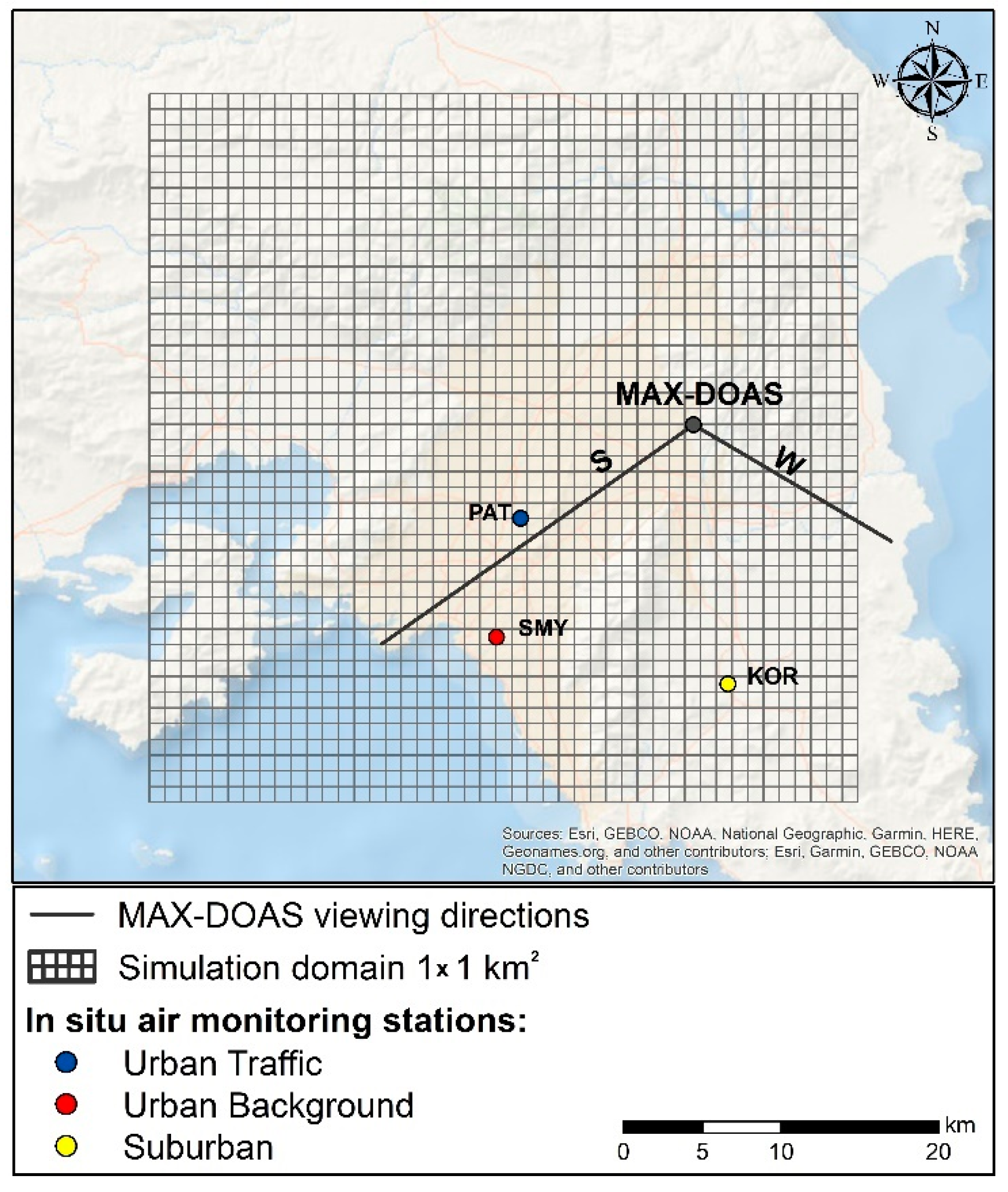
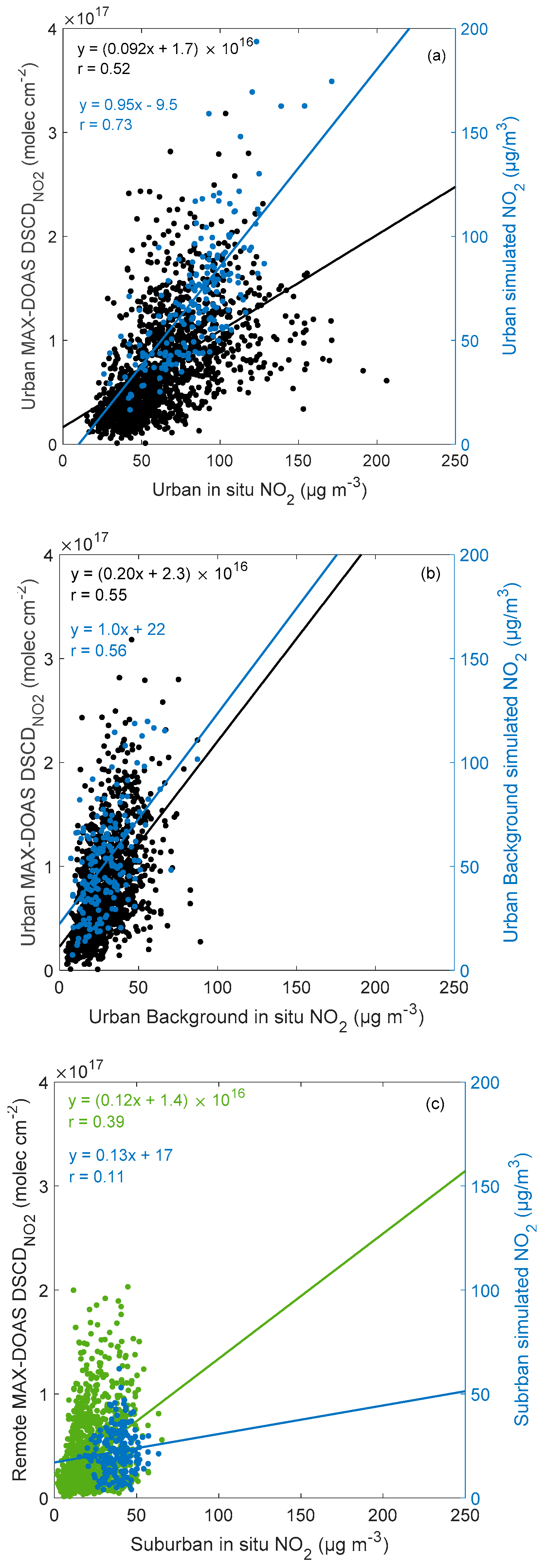
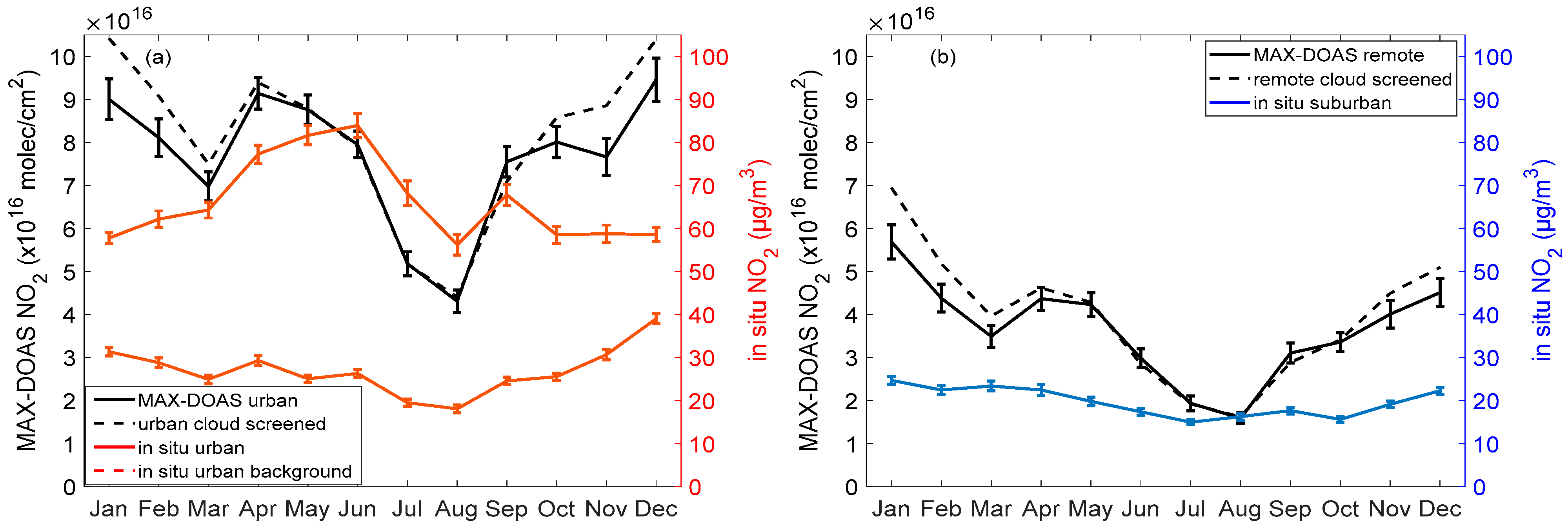
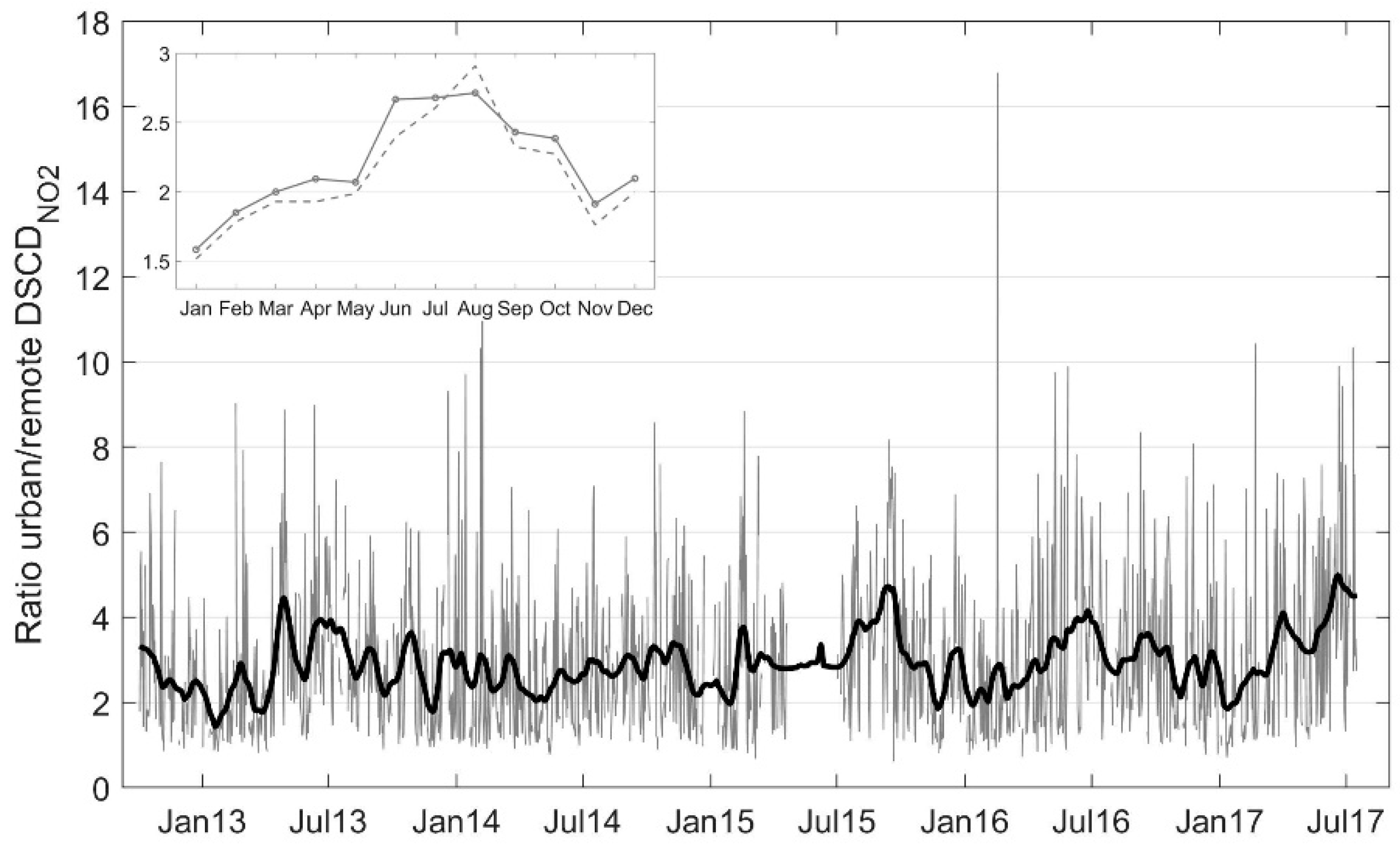
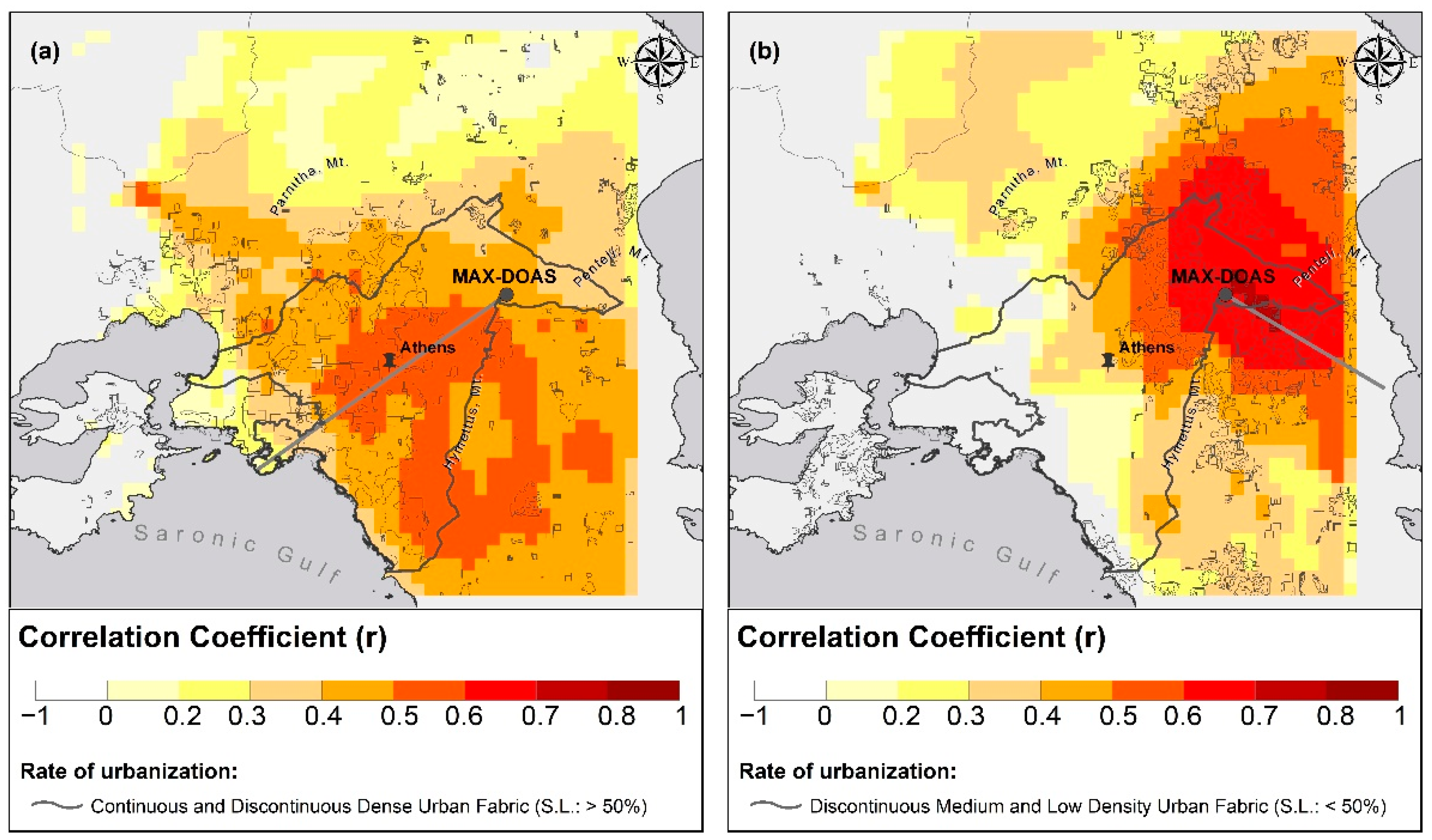


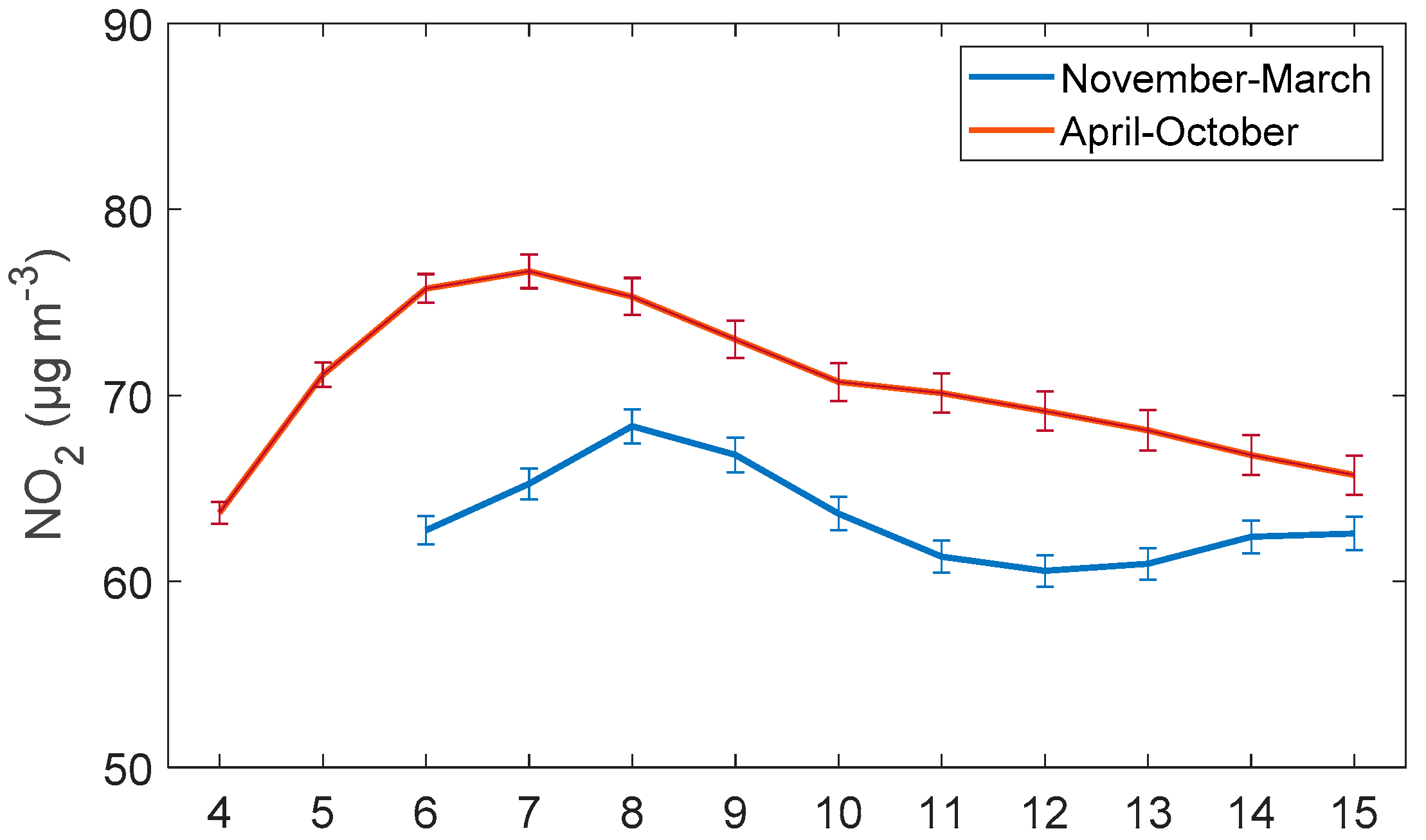
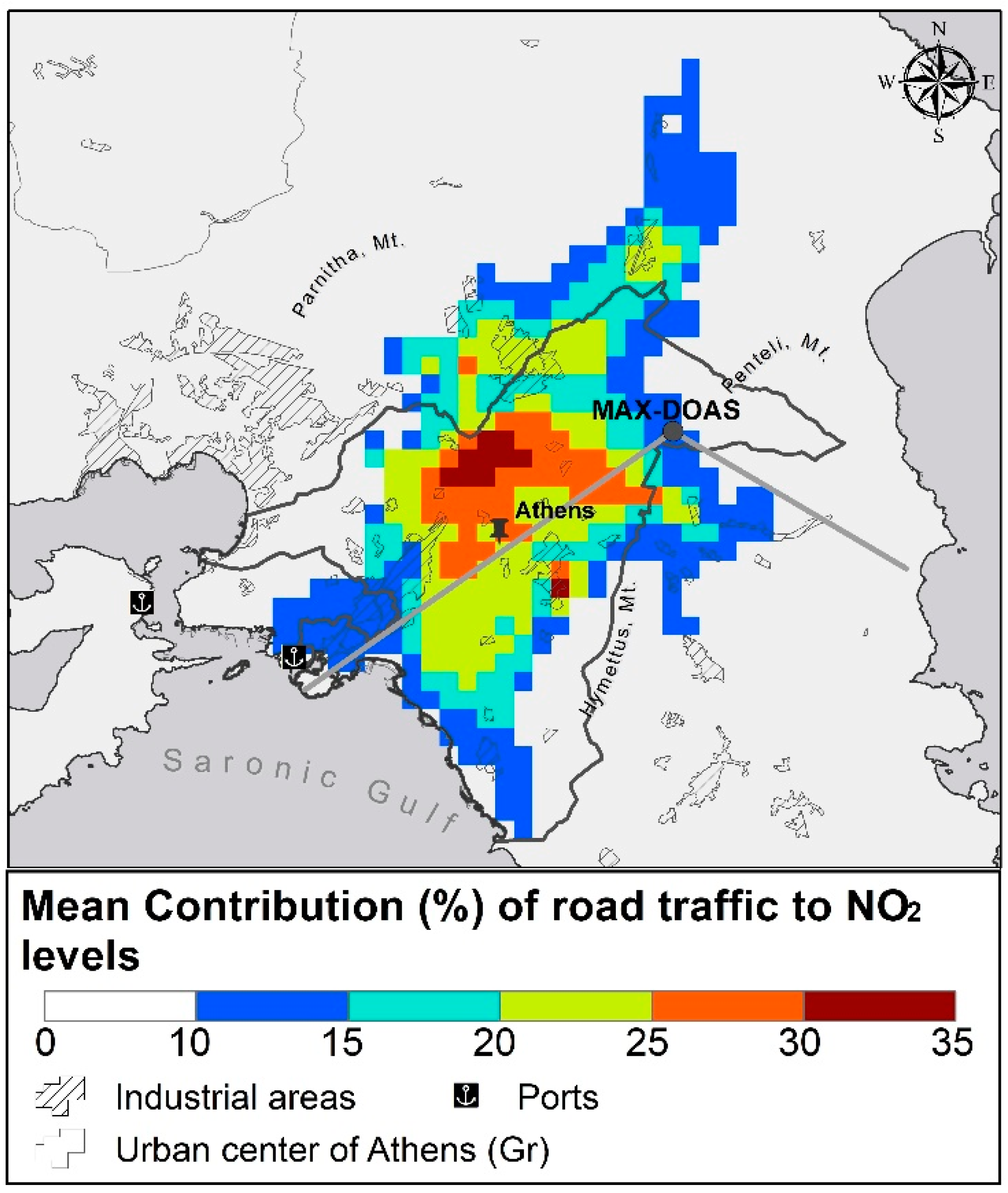

| MAX-DOAS | North Section (303.75°–56.25°) | South Section (123.75°–236.25°) | East Section (56.25°–123.75°) | West Section (236.25°–303.75°) | |
|---|---|---|---|---|---|
| In Situ | |||||
| urban | 0.50 | 0.43 | 0.38 | 0.46 | |
| urban | |||||
| urban | 0.47 | 0.51 | 0.31 | 0.40 | |
| urban background | |||||
| remote | 0.35 | 0.37 | 0.38 | 0.29 | |
| suburban |
| Sites | Mean In Situ NO2 Measurements (μg m−3) | Mean MAX-DOAS NO2 Measurements (molec cm−2) | Mean Model NO2 Simulations (μg m−3) | ||||
|---|---|---|---|---|---|---|---|
| October 2012– July 2017 | Cold Period (Nov–Mar) | Warm Period (Apr–Oct) | October 2012– July 2017 | Cold Period (Nov–Mar) | Warm Period (Apr–Oct) | January 2016– June 2016 | |
| Urban | 66.04 | 59.43 | 70.22 | 7.73 × 1016 | 8.22 × 1016 | 7.33 × 1016 | 71.10 MB = −13.6 Norm. MAE = 25% FAC2 = 97% |
| Urban background | 27.13 | 30.89 | 24.29 | - | - | - | 51.30 MB = 22.9 Norm. MAE = 103% FAC2 = 59% |
| Suburban background/Remote | 18.99 | 21.12 | 17.44 | 3.68 × 1016 | 4.40 × 1016 | 3.11 × 1016 | 22.3 MB = −15.7 Norm. MAE = 43% FAC2 = 58% |
| Sites | Winter (December–February) | Summer (June–August) | ||||
|---|---|---|---|---|---|---|
| Weekdays molec cm−2 | Sundays molec cm−2 | Contribution % | Weekdays molec cm−2 | Sundays molec cm−2 | Contribution % | |
| Urban | 9.04 ×1016 | 6.68 × 1016 | 26.1 | 5.94 × 1016 | 4.58 × 1016 | 22.9 |
| Remote | 4.94 ×1016 | 3.64 × 1016 | 26.3 | 2.25 × 1016 | 1.83 × 1016 | 18.7 |
Publisher’s Note: MDPI stays neutral with regard to jurisdictional claims in published maps and institutional affiliations. |
© 2021 by the authors. Licensee MDPI, Basel, Switzerland. This article is an open access article distributed under the terms and conditions of the Creative Commons Attribution (CC BY) license (https://creativecommons.org/licenses/by/4.0/).
Share and Cite
Gratsea, M.; Athanasopoulou, E.; Kakouri, A.; Richter, A.; Seyler, A.; Gerasopoulos, E. Five Years of Spatially Resolved Ground-Based MAX-DOAS Measurements of Nitrogen Dioxide in the Urban Area of Athens: Synergies with In Situ Measurements and Model Simulations. Atmosphere 2021, 12, 1634. https://doi.org/10.3390/atmos12121634
Gratsea M, Athanasopoulou E, Kakouri A, Richter A, Seyler A, Gerasopoulos E. Five Years of Spatially Resolved Ground-Based MAX-DOAS Measurements of Nitrogen Dioxide in the Urban Area of Athens: Synergies with In Situ Measurements and Model Simulations. Atmosphere. 2021; 12(12):1634. https://doi.org/10.3390/atmos12121634
Chicago/Turabian StyleGratsea, Myrto, Eleni Athanasopoulou, Anastasia Kakouri, Andreas Richter, Andre Seyler, and Evangelos Gerasopoulos. 2021. "Five Years of Spatially Resolved Ground-Based MAX-DOAS Measurements of Nitrogen Dioxide in the Urban Area of Athens: Synergies with In Situ Measurements and Model Simulations" Atmosphere 12, no. 12: 1634. https://doi.org/10.3390/atmos12121634
APA StyleGratsea, M., Athanasopoulou, E., Kakouri, A., Richter, A., Seyler, A., & Gerasopoulos, E. (2021). Five Years of Spatially Resolved Ground-Based MAX-DOAS Measurements of Nitrogen Dioxide in the Urban Area of Athens: Synergies with In Situ Measurements and Model Simulations. Atmosphere, 12(12), 1634. https://doi.org/10.3390/atmos12121634







